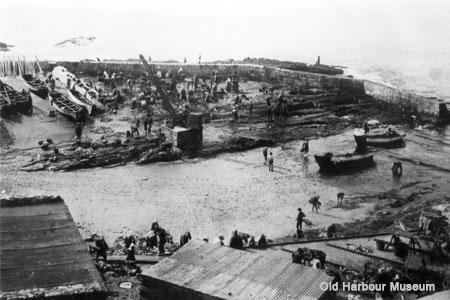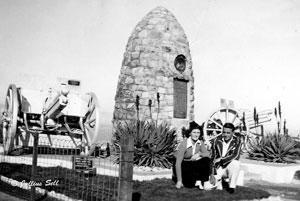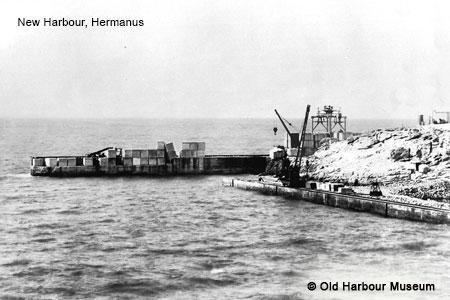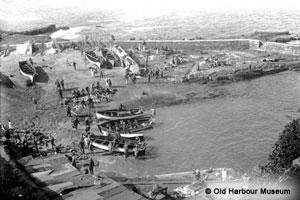Old Harbour Museum, Hermanus
The Old Harbour Open-Air Museum (including the Old Harbour itself) is a provincial heritage site. It is unique in that apparently it is one of only two fishing harbours in the world that has been conserved in tact. Remnants of the vibrant fishing industry are seen everywhere. It is the axis around which the fishing village of Hermanus developed.
The stone and concrete harbour consist of a sea wall, a breakwater, a few historic fishing boats along concrete slopes, the turn stone, gutting tables, brine tanks, “bokkom” stands and reconstructed fishing shacks. Some of the brine tanks have been planted with indigenous “veldkos” (food from the bush), with descriptive labels as to the usage of the plants. Along the slopes valuable coastal fynbos has been re-established.
Old Harbour
 Ever since 1855 People were drawn to Hermanus by the variety and abundance of fish since the early 1850’s that could be harvested from the sea. The Old Harbour provided a safe haven for the small fishing boats. The return of the boats to the inlet at the Old Harbour was an exciting event each day for more than a century.
Ever since 1855 People were drawn to Hermanus by the variety and abundance of fish since the early 1850’s that could be harvested from the sea. The Old Harbour provided a safe haven for the small fishing boats. The return of the boats to the inlet at the Old Harbour was an exciting event each day for more than a century.
Onlookers would see the tiny boats ride the heavy seas at the entrance to the harbour - waiting for a break between swells to allow them to row their small boats into the safety of the harbour.
"Visbaai"
Large crowds of local residents would gather at “Visbaai” (as the Old Harbour was known), to watch this daily event of fish being carried ashore, gutted and sold while the boats were lifted and put on the turning-stone before being carried up the slipway by 16 men. Some fish were salted and packed in crates to be transported to other towns. Snoek and harders were salted and dried on the “bokkom” stands in the area or in the backyards of the fishermen.
As the fishing industry in “Visbaai” grew, so did the need to make the harbour safer. A breakwater was built in 1904 and a crane was built to lift the boats out of the water, but it wasn’t very successful. The first boat lifted was completely crushed and after a second attempt the crane was abandoned. The fishermen erected stone huts with iron roofs in which they could store their oars, sails, fishing tackle, etc. The brine tanks were built in which to salt the fish before drying.
The SAR&H took over the jurisdiction of the Old Harbour in 1919 and remained responsible for the facility until 1950 when it was officially proclaimed a harbour.
“Visbaai” was a popular shark catching spot. It was a very popular form of entertainment and everyone would gather to watch.
 Bill Selkirk, also known as the “shark enemy” of the world, specially made this activity popular. He caught a world record shark in April 1922. Selkirk, more than anybody else, put Hermanus on the world’s fishing map. He had a greatsense of adventure, probably a characteristic he inherited from one of his forefathers, Alexander Selkirk (better known as Robinson Crusoe!). The jaws of this world record shark are also displayed in the Selkirk Room in the Fisherman’s Cottage Photographic Museum.
Bill Selkirk, also known as the “shark enemy” of the world, specially made this activity popular. He caught a world record shark in April 1922. Selkirk, more than anybody else, put Hermanus on the world’s fishing map. He had a greatsense of adventure, probably a characteristic he inherited from one of his forefathers, Alexander Selkirk (better known as Robinson Crusoe!). The jaws of this world record shark are also displayed in the Selkirk Room in the Fisherman’s Cottage Photographic Museum.
In March 1960 the derelict iron huts at the old harbour were removed and in 1970 the Old Harbour was declared a national monument.
The idea of a museum was the brainchild of Dr Ion Williams in 1968. His idea was to restore the old harbour to its former glory. For many years the area served as the economic and social hub of Hermanus. With the assistance of a few interested persons a committee was formed and the foundations for a museum were formulated. Consequently the ‘Friends of the Old Harbour Museum Association’ was established and the first AGM was held on 13 December 1971. In 1972 the old harbour was proclaimed a Provincial Museum and the development of an open- air museum was started. A Board of Trustees was established and Guy Clarke was appointed first curator with Daniel his assistant. Duties commenced on 13 April 1973.
The area was cleaned up, cement work repaired and an indoor museum planned and built along the slopes where many old fishing shacks stood in the earlier days. Old fishing boats were collected and repaired for open air museum.
In 1990 the first phase of the Allengenski Complex that used to be the oldest building in the harbour, was reconstructed. The second phase was completed in 1994 and now houses the new offices. As the need arose for environmental education, an environmental forum was formed with nature conversation and a centre sponsored by Sea Plant Products was built as an extension of the indoor museum.
The Hans Moore Educational Centre is used for a variety of programmes such as talks on inter-tidal zones, whales, coastal fynbos, sharks, etc. Specific programmes are offered to schools during National Marine Day, Water Week and Heritage Day. There is a specimen display of coastal fynbos linked to the Hermanus Botanical Society display in Fernkloof. The brine anks contain a “veldkos” (food from the bush) garden with descriptive labels as to the usage of the plants. During the last few years a section of the centre is also being used to rebuild some of the deteriorating old fishing boats. This is of great interest to the visitors.
 The museum consists of two sections: The historical old fishing harbour, which include the indoor and open-air museum, and Fishermen’s Village which includes the Fisherman’s Cottage Photographic Museum.
The museum consists of two sections: The historical old fishing harbour, which include the indoor and open-air museum, and Fishermen’s Village which includes the Fisherman’s Cottage Photographic Museum.
The museum building was erected in 1977 and is a replica of the buildings which stood in the harbour in 1915. The indoor museum houses some of the items used in the fishing industry in the early part of the century, as well as some items of the Selkirk Collection; the angling paradise and a variety of seawater aquariums displaying life forms found locally in the inter-tidal zones.
The open-air museum contains a sea wall, old fishing boats, gutting tables, brine tanks, “bokkom” stands and reconstructed fishing shacks. One of these shacks originally served as South Africa’s very first perlemoen hatchery.
The War Memorial
 , erected in 1929 to the memory of those who died in the war, leads down to the harbour. Hermanus sent more men to both wars than any other town in South Africa, and in recognition, the Union Government presented two field guns as trophies to be mounted on either side of the stone cairn. They eventually fell into disrepair and were replaced in 1963 by the present naval guns. The bronze plaque contains the names of those who died in both wars.
, erected in 1929 to the memory of those who died in the war, leads down to the harbour. Hermanus sent more men to both wars than any other town in South Africa, and in recognition, the Union Government presented two field guns as trophies to be mounted on either side of the stone cairn. They eventually fell into disrepair and were replaced in 1963 by the present naval guns. The bronze plaque contains the names of those who died in both wars.
New Harbour


The building of a new harbour commenced during the Second World War and was completed after 1945. The fishermen gradually left the Old Harbour for the greater convenience of the New Harbour.
Photo above right: New Habour 1981
Call us and schedule your listing today! Contact Us
Copyright © 2025 Hermanus Online Magazine. Web Development by Jaydee media.

